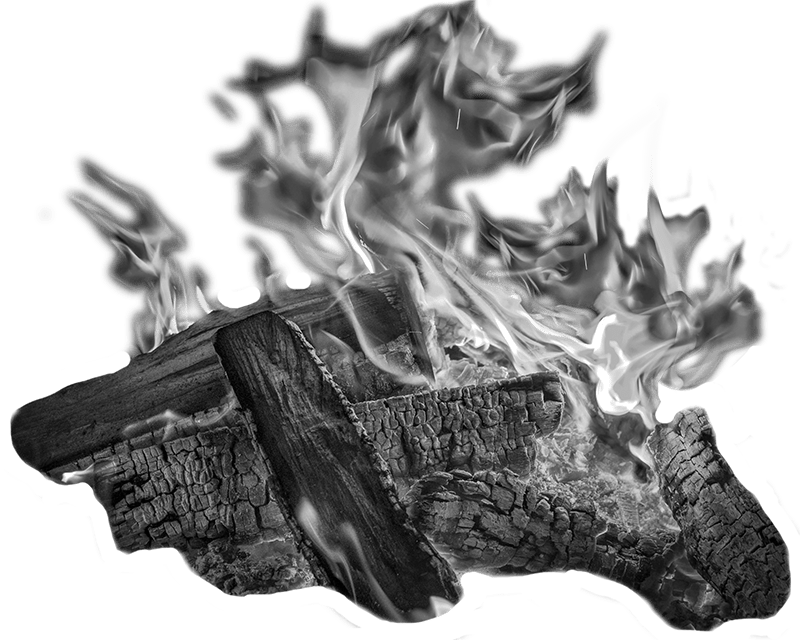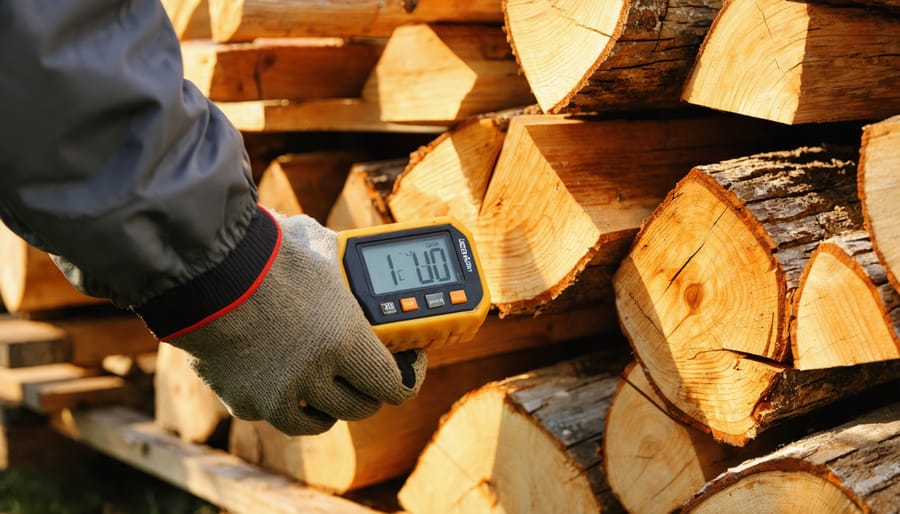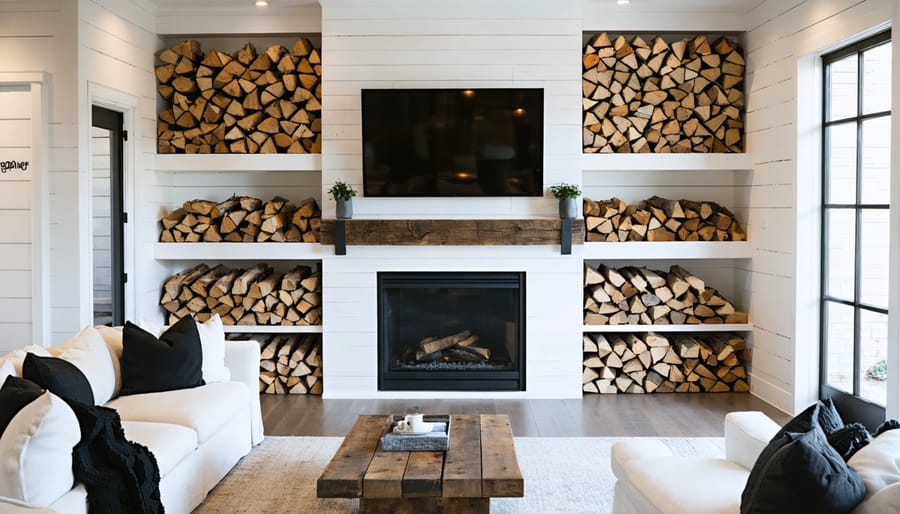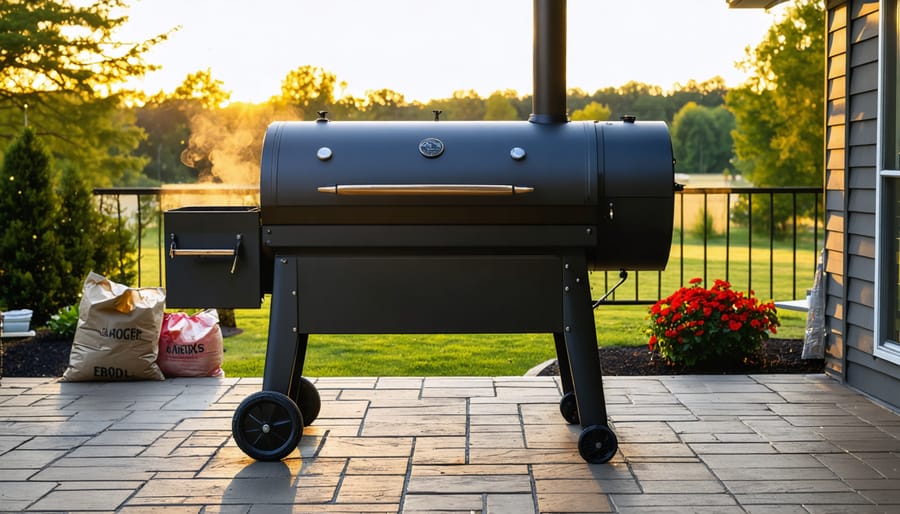Plan your firewood purchases 6-18 months before you need them, depending on species—dense hardwoods like oak require a full year or more, while softer woods like pine can be ready in just six months. Stack your split wood in a sunny, wind-exposed location with the top covered but sides open, allowing air circulation to drop moisture content below the critical 20% threshold that separates smoky, inefficient fires from clean-burning warmth.
Check seasoning progress by striking two pieces together—properly dried wood produces a sharp crack rather than a dull thud—or invest in an inexpensive moisture meter to eliminate guesswork entirely. The difference between seasoned and green wood isn’t just about convenience; wet firewood creates dangerous creosote buildup in your chimney, wastes up to 25% of potential heat energy, and fills your home with smoke instead of the cozy ambiance you’re seeking.
Different wood species season at dramatically different rates due to variations in density, water content, and natural oils. Ash and birch dry relatively quickly at 6-12 months, making them excellent choices for those new to wood heating or working with limited storage space. Meanwhile, premium hardwoods like hickory and oak demand patience—12-24 months of proper seasoning—but reward you with longer burn times and superior heat output that justifies the wait.
Understanding these timelines transforms firewood management from frustrating trial-and-error into a predictable, sustainable heating solution that enhances both your home’s comfort and your environmental footprint.
Understanding Firewood Moisture Content
What Is Seasoned Firewood?
Seasoned firewood is wood that has been properly dried to reduce its moisture content, transforming freshly cut “green” wood into fuel that burns efficiently and safely in your fireplace or wood stove. Think of it as allowing your firewood to breathe and shed the water trapped inside its fibers, much like how a sponge dries out when left in the sun.
When a tree is first cut, it contains a significant amount of water within its cell walls and cavities, sometimes up to 50% of its total weight. During the seasoning process, this moisture gradually evaporates from the wood’s surface and interior. At a cellular level, the water molecules bound within the wood fibers break free and escape into the surrounding air, leaving behind denser, energy-rich wood that’s ready to burn.
Properly seasoned firewood typically reaches a moisture content of 20% or less, which is the sweet spot for optimal burning. This transformation doesn’t happen overnight. It requires time, proper air circulation, and the right storage conditions to allow nature to work its magic, turning heavy, hissing green logs into the perfect fuel for cozy evenings by the fire.
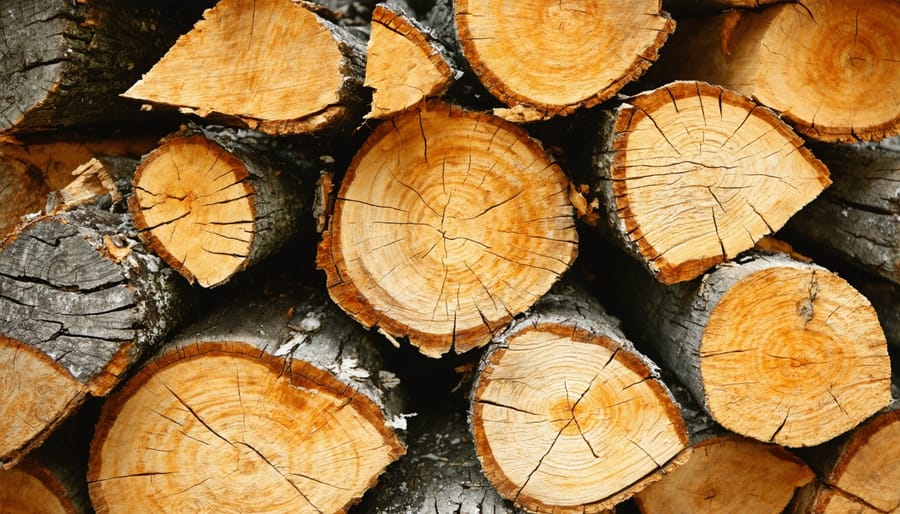
Why Moisture Content Makes or Breaks Your Fire
Understanding moisture content is the key to transforming your firewood from a smoking, sputtering disappointment into the cozy, efficient heat source you’re dreaming of. Here’s why it matters so much: when you burn wet or green wood, a significant portion of your fire’s energy gets wasted simply evaporating water trapped inside the wood fibers. Think of it this way—instead of warming your living room, you’re essentially boiling off moisture that should have dried naturally during seasoning.
Properly seasoned firewood with moisture content below 20% burns hotter, cleaner, and more efficiently. Wet wood, on the other hand, produces excessive smoke that can irritate your eyes and lungs while sending pollutants into your neighborhood. That thick smoke also creates dangerous creosote buildup in your chimney, increasing fire risks and maintenance costs.
From an eco-friendly perspective, burning well-seasoned wood significantly reduces your environmental footprint. You’ll use less wood to produce the same warmth, meaning fewer trees harvested and fewer emissions released. Plus, you’ll enjoy the crackling flames and radiant heat that make a fireplace such a wonderful lifestyle element—without the guilt of unnecessary waste or pollution clouding your experience.
The Complete Firewood Seasoning Time Chart
Hardwoods: The Long Game
When it comes to hardwoods, patience truly is a virtue. These dense, high-energy woods are the gold standard for home heating, delivering longer burn times and more BTUs per log than their softwood cousins. However, that density comes with a trade-off: they take considerably longer to season properly.
Oak stands as the king of firewood but demands the longest commitment at 18-24 months of seasoning time. Its tight grain structure holds moisture stubbornly, and rushing the process means you’ll end up with wood that’s difficult to ignite and produces excessive smoke and creosote buildup. Red oak typically seasons slightly faster than white oak due to its more porous nature, but both varieties reward your patience with exceptional heat output and extended burn times that make those long winter evenings truly cozy.
Maple falls into the moderate category at 12-18 months. Sugar maple and red maple are both excellent choices for creating that warm, inviting atmosphere in your home while providing reliable, steady heat. The wood splits relatively easily and seasons more predictably than oak, making it a favorite among homeowners who plan ahead but don’t want to wait two full years.
Ash is the overachiever of the hardwood family, ready to burn in just 6-12 months. Its lower initial moisture content and open grain structure allow it to dry faster without sacrificing heat quality. This makes ash perfect if you’re building your firewood supply and need something ready for the upcoming season.
Hickory requires 12-24 months and produces some of the highest heat output available. Birch, at around 12 months, burns hot and fast, though its papery bark makes it slightly more prone to rot if not stored properly under cover.
The variation in seasoning times comes down to wood density, grain structure, and initial moisture content. Planning your firewood supply around these timelines ensures you’ll always have properly seasoned wood ready when temperatures drop.
Softwoods: Quick to Season
If you’re looking for firewood that’s ready to burn relatively quickly, softwoods are your answer. These lighter, less dense woods contain more air pockets and typically have lower moisture content when freshly cut, meaning they’ll be ready to warm your home in significantly less time than their hardwood counterparts.
Pine seasons in just 6-8 months, making it one of the fastest options for replenishing your wood supply. Fir requires 6-12 months depending on the species and your climate, while cedar is often ready in about 6 months. Spruce falls somewhere in the middle at 6-9 months. The key is proper stacking with good airflow and protection from rain, which allows these woods to shed moisture efficiently.
Now, before you stock up entirely on softwoods, it’s important to understand when they shine brightest. Softwoods burn hotter and faster than hardwoods, producing more flame and less sustained heat. This makes them perfect for shoulder season fires in spring and fall when you want quick warmth without overheating your space. They’re also wonderful for getting hardwood fires started or creating that cozy, crackling ambiance on a crisp evening.
The trade-off? You’ll go through your softwood supply faster, and you’ll need to tend the fire more frequently. Softwoods also produce more creosote buildup in your chimney, so regular cleaning becomes even more important for safety. Many homeowners find the sweet spot is keeping a mix of both softwoods for convenience and hardwoods for those long, cold winter nights when efficiency matters most.
What Affects These Timelines
Several key factors influence how quickly your firewood reaches that perfect, fireplace-ready state. Your local climate plays the starring role—wood seasons much faster in warm, dry climates with good air circulation than in humid or consistently damp regions. Summer months naturally accelerate the drying process, which is why splitting wood in early spring gives you the best advantage.
The size of your wood pieces matters tremendously. Smaller splits with more exposed surface area dry exponentially faster than large rounds. Aim for pieces around 3-6 inches in diameter for optimal results. Your storage method can make or break your seasoning timeline too. Wood stacked off the ground with proper airflow and a protective top cover can season in half the time of wood piled directly on soil or completely covered.
Finally, the initial moisture content when you cut or purchase wood significantly affects your waiting period. Freshly cut green wood might contain 50-60% moisture, while partially dried wood gives you a valuable head start on your seasoning journey.
How to Properly Season Your Firewood
Split It Right
Here’s the thing about splitting your firewood: it’s not just about making pieces fit in your fireplace. When you split a log, you dramatically increase the surface area exposed to air, allowing moisture to escape much faster from the interior. Think of it like drying laundry—a crumpled shirt takes forever, but spread it out and it dries quickly.
For optimal seasoning, aim for splits about 4 to 6 inches in diameter. Pieces in this range dry efficiently while still providing substantial burn time. Whether you prefer a splitting axe or maul or you’re using wedges for splitting, the best time to split is right after felling, when the wood contains more moisture and splits more easily.
Following safe wood splitting techniques ensures you’ll have properly sized pieces that season faster, giving you beautifully dry firewood for those cozy evenings by the fire.
Stack for Airflow
How you stack your firewood can dramatically affect how quickly it dries and whether it stays dry throughout the seasoning process. Think of your woodpile as a breathing structure that needs consistent airflow to work efficiently.
The foundation matters most. Always elevate your firewood at least four to six inches off the ground using pallets, pressure-treated lumber, or concrete blocks. This prevents ground moisture from wicking up into your wood and protects the bottom layer from rot and insects.
For the stacking pattern itself, the traditional criss-cross method works beautifully. Stack your logs parallel in one direction, then create perpendicular layers on top. This creates natural air channels throughout the pile. Pay special attention to the ends of your stack where you can build support towers using this criss-cross technique every four feet or so.
Leave about three to five inches of space between individual rows of stacked wood. This spacing allows wind to circulate freely, carrying away moisture as it evaporates. Some enthusiasts swear by the holz hausen method, a circular German technique that resembles a beehive and naturally sheds water while promoting excellent airflow.
Position your woodpile in a sunny, breezy location if possible. Southern exposure helps accelerate drying, and placing it away from dense vegetation ensures better air circulation around all sides.
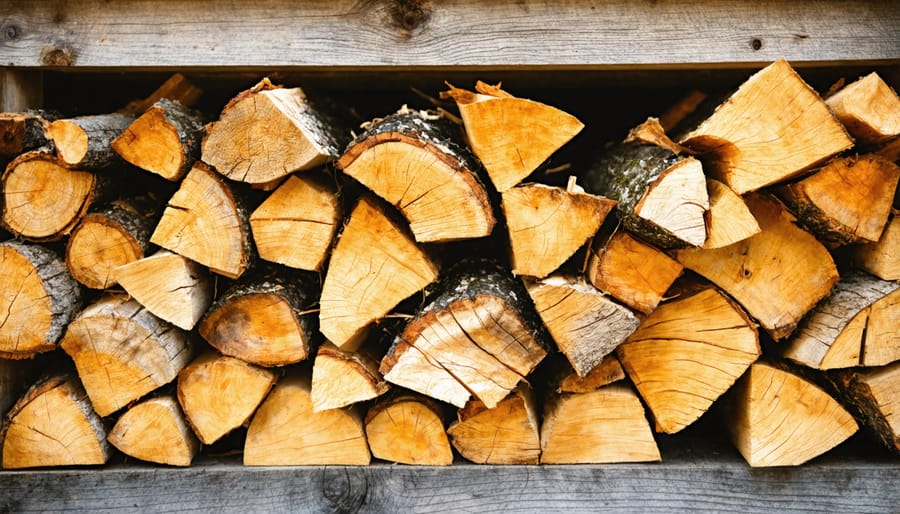
Location and Protection
Where you stack your firewood matters just as much as how you stack it. Think of your woodpile as a living thing that needs the right environment to thrive. The ideal spot receives plenty of sunlight and catches a good breeze, both nature’s best tools for drawing moisture out of your logs.
Position your stack in an area that gets at least six hours of direct sunlight daily, preferably facing south or southwest. Wind flow is equally important since moving air carries moisture away from the wood surface. Avoid placing stacks directly against walls or in enclosed sheds where air circulation is limited.
When it comes to covering, less is often more. The best approach is covering only the top 12-18 inches of your stack with a tarp or metal roof while leaving the sides completely exposed. This prevents rain and snow from soaking into the pile while allowing crucial side ventilation that keeps air moving through the stack. A full tarp wrap might seem protective, but it actually traps moisture inside, creating a humid environment that encourages mold and slows seasoning dramatically.
Think of it as giving your firewood an umbrella rather than a raincoat. This balanced approach to protection ensures your wood dries efficiently while staying ready for those cozy evenings by the fire.
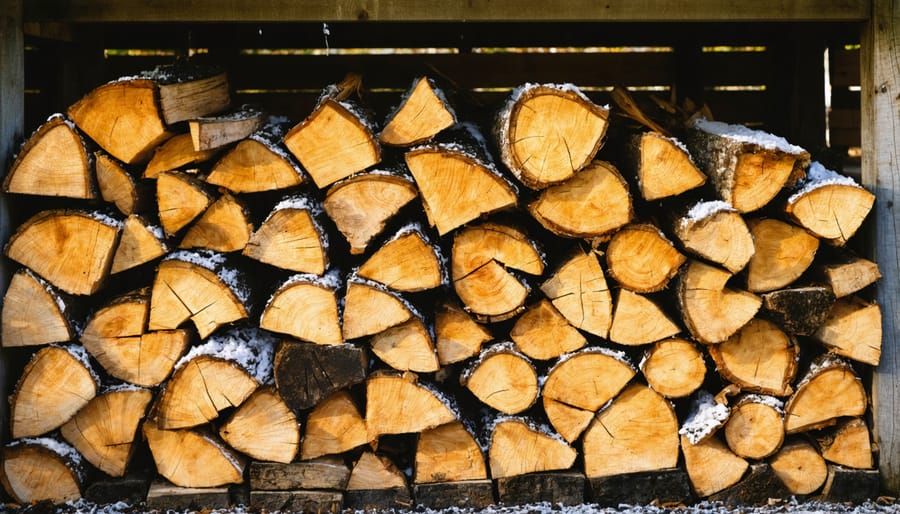
Testing Your Firewood’s Moisture Content
Using a Moisture Meter
A moisture meter takes the guesswork out of determining whether your firewood is ready to burn. These affordable devices, typically costing between $20-50, are essential tools for anyone serious about enjoying efficient, clean-burning fires.
To get accurate readings, always test the split face of your firewood, never the bark or end grain. The bark can hold moisture even when the interior is dry, giving you misleadingly high numbers. Split a piece of wood lengthwise and immediately insert the meter’s pins about a half-inch deep into the freshly exposed surface. Take readings from multiple pieces in your stack to get a reliable average.
Your goal is a moisture content reading of 20% or below. This is the sweet spot where wood burns efficiently, produces maximum heat, and creates minimal creosote buildup in your chimney. Wood between 20-25% will burn, but not optimally. Anything above 25% is still too wet and will struggle to ignite, smoke excessively, and waste energy evaporating water instead of warming your home.
For best results, test several spots on each piece, especially near the center where moisture tends to linger longest. This simple practice ensures you’re bringing only properly seasoned wood into your home, protecting both your heating efficiency and your family’s comfort.

Old-School Testing Methods
Before moisture meters became common, generations of firewood users relied on tried-and-true methods that remain remarkably effective today. These simple techniques help you confirm your wood is ready for a cozy, efficient fire.
Start with a visual inspection. Well-seasoned firewood displays deep radial cracks on the ends where moisture has escaped. The bark should be loose or falling off entirely, and you’ll notice the wood has lost its fresh-cut sheen, taking on a duller, grayed appearance instead of that bright, freshly-split look.
Pick up a piece and compare it to green wood of similar size. Seasoned firewood feels noticeably lighter since water weight accounts for much of green wood’s heft. This weight test is one of the most reliable old-school methods available.
Try the knock test by clapping two pieces together. Dry wood produces a sharp, hollow crack, while wet wood makes a dull thud. Think of it like the difference between striking a bell and hitting a wet sponge.
Finally, check the wood’s temperature. Seasoned firewood feels room temperature or slightly cool, while green wood retains a noticeable chill from internal moisture. These eco-friendly verification methods cost nothing and work anywhere, making them perfect for homeowners committed to burning only properly prepared firewood.
Shortcuts and When to Buy Pre-Seasoned
Kiln-Dried: The Fast Track
If patience isn’t your strong suit, kiln-dried firewood offers an appealing shortcut. This commercially processed wood has been heated in large kilns to rapidly reduce moisture content to optimal burning levels, typically 15-20%. You can burn it immediately, making it perfect for spontaneous cozy evenings or when you’ve simply run short on your seasoned supply.
The convenience comes at a premium, though. Kiln-dried wood costs roughly two to three times more than green wood, and even exceeds the price of naturally seasoned cordwood. For occasional fireplace users or those without storage space for seasoning, this investment makes sense. You’ll enjoy cleaner burns, less creosote buildup, and zero waiting time.
Consider kiln-dried as your backup plan rather than your primary source. It’s ideal for supplementing your seasoned stash during unexpectedly cold stretches or when entertaining guests. From an eco-friendly perspective, kiln-drying does consume energy, so balancing convenience with sustainability means reserving it for situations where the time-saving truly matters to your household’s comfort and lifestyle.
Buying Smart: Avoiding Wet Wood Scams
Finding a trustworthy firewood supplier makes all the difference in your heating season experience. When shopping for firewood, start by asking suppliers about their seasoning process and how long the wood has been cut and split. A reputable vendor should readily share this information and won’t mind if you inspect the wood before purchasing.
Watch for red flags like significantly lower prices than competitors, reluctance to let you see the wood pile, or claims that all wood is “ready to burn immediately.” Fresh-cut wood often appears darker with tight bark, while properly seasoned wood shows cracks in the end grain and loose, flaking bark.
Bring a moisture meter when visiting suppliers and ask to test several pieces from the middle of the pile, not just the outer layers. Honest vendors appreciate informed customers and won’t hesitate to demonstrate their wood’s quality.
Building a relationship with a reliable supplier benefits both of you. Many established vendors offer delivery discounts for repeat customers and will set aside premium wood for their loyal clientele. Don’t hesitate to ask neighbors with wood stoves for recommendations, as word-of-mouth remains the best way to find dependable firewood sources in your community.
Common Firewood Seasoning Mistakes
Even experienced firewood users can fall into common traps that significantly extend seasoning time or result in wood that never properly dries. Understanding these mistakes helps you avoid frustration and ensures you’ll have quality firewood when cold weather arrives.
One of the most frequent errors is stacking wood too tightly. When logs are crammed together without adequate spacing, air can’t circulate between them, trapping moisture inside your woodpile. Think of it like hanging wet laundry in a closet versus on a line with space around each piece. Your firewood needs breathing room. Aim for gaps between rows and avoid creating a solid wall of wood.
Inadequate coverage presents another challenge for homeowners. While you want protection from rain and snow, completely covering your woodpile with tarps or plastic creates a moisture trap. The best approach is covering only the top third of your stack, leaving the sides exposed for airflow. This shields your wood from direct precipitation while allowing moisture to escape naturally.
Location matters more than many realize. Storing firewood directly on the ground invites moisture absorption and insect problems. Additionally, placing your stack in a shaded, protected corner might seem sensible, but wood seasons fastest in sunny, breezy spots. Elevate your woodpile on pallets or rails and position it where it receives sun exposure and wind.
Perhaps the biggest mistake is impatience. Expecting wood to season in just a few months rarely works, especially with dense hardwoods that naturally require longer drying periods. The seasoning time chart provides realistic expectations, helping you plan ahead rather than rushing the process. Remember, properly seasoned wood is an investment in better fires, cleaner burning, and a more enjoyable hearth experience throughout winter.
Patience truly is the secret ingredient to exceptional fires. While it might be tempting to rush the process, remember that properly seasoned firewood transforms your entire fireplace experience from frustrating to fantastic. The timelines we’ve covered—whether it’s the six-month minimum for softer woods or the full year needed for dense hardwoods—aren’t just suggestions. They’re your roadmap to cozy evenings without the headaches of smoky rooms, creosote buildup, and underperforming fires.
Before you light that first match, take a moment to test your wood using the moisture meter method or the simple knock test. This small step protects your chimney, keeps your home safer, and ensures you’ll actually get the warmth you’re counting on. Well-seasoned firewood burns hotter, cleaner, and longer, meaning less time tending the fire and more time enjoying it with family.
Here’s your final takeaway: start planning for next season now. Whether it’s late winter or early spring, that’s your window to split and stack wood for the following year. This forward-thinking approach means you’ll never scramble for dry wood again, and your fireplace becomes the reliable, eco-friendly heat source it was meant to be.
